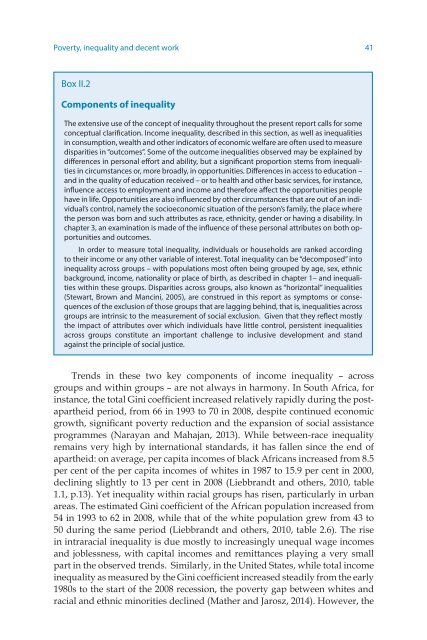Leaving no one behind the imperative of inclusive development
full-report
full-report
Create successful ePaper yourself
Turn your PDF publications into a flip-book with our unique Google optimized e-Paper software.
Poverty, inequality and decent work 41<br />
Box II.2<br />
Comp<strong>one</strong>nts <strong>of</strong> inequality<br />
The extensive use <strong>of</strong> <strong>the</strong> concept <strong>of</strong> inequality throughout <strong>the</strong> present report calls for some<br />
conceptual clarification. Income inequality, described in this section, as well as inequalities<br />
in consumption, wealth and o<strong>the</strong>r indicators <strong>of</strong> eco<strong>no</strong>mic welfare are <strong>of</strong>ten used to measure<br />
disparities in “outcomes”. Some <strong>of</strong> <strong>the</strong> outcome inequalities observed may be explained by<br />
differences in personal effort and ability, but a significant proportion stems from inequalities<br />
in circumstances or, more broadly, in opportunities. Differences in access to education –<br />
and in <strong>the</strong> quality <strong>of</strong> education received – or to health and o<strong>the</strong>r basic services, for instance,<br />
influence access to employment and income and <strong>the</strong>refore affect <strong>the</strong> opportunities people<br />
have in life. Opportunities are also influenced by o<strong>the</strong>r circumstances that are out <strong>of</strong> an individual’s<br />
control, namely <strong>the</strong> socioeco<strong>no</strong>mic situation <strong>of</strong> <strong>the</strong> person’s family, <strong>the</strong> place where<br />
<strong>the</strong> person was born and such attributes as race, ethnicity, gender or having a disability. In<br />
chapter 3, an examination is made <strong>of</strong> <strong>the</strong> influence <strong>of</strong> <strong>the</strong>se personal attributes on both opportunities<br />
and outcomes.<br />
In order to measure total inequality, individuals or households are ranked according<br />
to <strong>the</strong>ir income or any o<strong>the</strong>r variable <strong>of</strong> interest. Total inequality can be “decomposed” into<br />
inequality across groups – with populations most <strong>of</strong>ten being grouped by age, sex, ethnic<br />
background, income, nationality or place <strong>of</strong> birth, as described in chapter 1– and inequalities<br />
within <strong>the</strong>se groups. Disparities across groups, also k<strong>no</strong>wn as “horizontal” inequalities<br />
(Stewart, Brown and Mancini, 2005), are construed in this report as symptoms or consequences<br />
<strong>of</strong> <strong>the</strong> exclusion <strong>of</strong> those groups that are lagging <strong>behind</strong>, that is, inequalities across<br />
groups are intrinsic to <strong>the</strong> measurement <strong>of</strong> social exclusion. Given that <strong>the</strong>y reflect mostly<br />
<strong>the</strong> impact <strong>of</strong> attributes over which individuals have little control, persistent inequalities<br />
across groups constitute an important challenge to <strong>inclusive</strong> <strong>development</strong> and stand<br />
against <strong>the</strong> principle <strong>of</strong> social justice.<br />
Trends in <strong>the</strong>se two key comp<strong>one</strong>nts <strong>of</strong> income inequality – across<br />
groups and within groups – are <strong>no</strong>t always in harmony. In South Africa, for<br />
instance, <strong>the</strong> total Gini coefficient increased relatively rapidly during <strong>the</strong> postapar<strong>the</strong>id<br />
period, from 66 in 1993 to 70 in 2008, despite continued eco<strong>no</strong>mic<br />
growth, significant poverty reduction and <strong>the</strong> expansion <strong>of</strong> social assistance<br />
programmes (Narayan and Mahajan, 2013). While between-race inequality<br />
remains very high by international standards, it has fallen since <strong>the</strong> end <strong>of</strong><br />
apar<strong>the</strong>id: on average, per capita incomes <strong>of</strong> black Africans increased from 8.5<br />
per cent <strong>of</strong> <strong>the</strong> per capita incomes <strong>of</strong> whites in 1987 to 15.9 per cent in 2000,<br />
declining slightly to 13 per cent in 2008 (Liebbrandt and o<strong>the</strong>rs, 2010, table<br />
1.1, p.13). Yet inequality within racial groups has risen, particularly in urban<br />
areas. The estimated Gini coefficient <strong>of</strong> <strong>the</strong> African population increased from<br />
54 in 1993 to 62 in 2008, while that <strong>of</strong> <strong>the</strong> white population grew from 43 to<br />
50 during <strong>the</strong> same period (Liebbrandt and o<strong>the</strong>rs, 2010, table 2.6). The rise<br />
in intraracial inequality is due mostly to increasingly unequal wage incomes<br />
and joblessness, with capital incomes and remittances playing a very small<br />
part in <strong>the</strong> observed trends. Similarly, in <strong>the</strong> United States, while total income<br />
inequality as measured by <strong>the</strong> Gini coefficient increased steadily from <strong>the</strong> early<br />
1980s to <strong>the</strong> start <strong>of</strong> <strong>the</strong> 2008 recession, <strong>the</strong> poverty gap between whites and<br />
racial and ethnic mi<strong>no</strong>rities declined (Ma<strong>the</strong>r and Jarosz, 2014). However, <strong>the</strong>
















